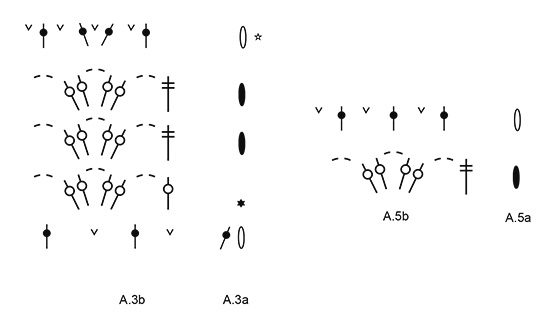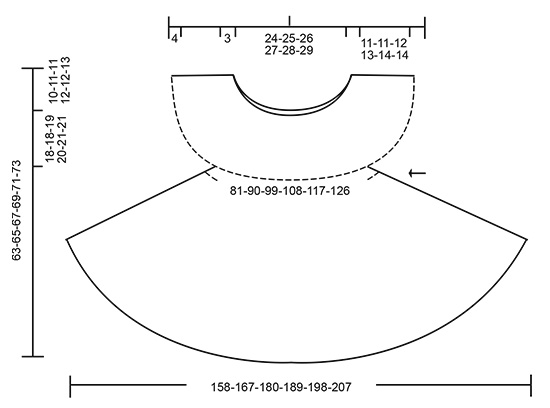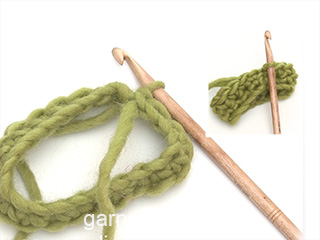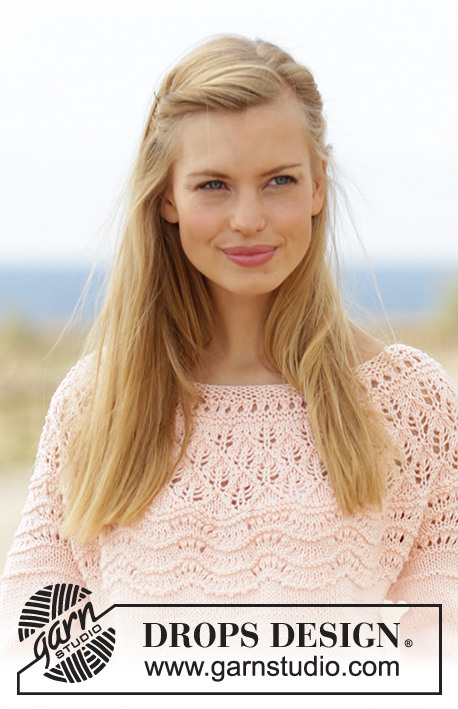Lizzy |
||||||||||||||||||||||||||||||||||||||||
 |
 |
|||||||||||||||||||||||||||||||||||||||
Tunic with fan pattern, flounce and A-shape, crochet top down in DROPS Safran. Size S-XXXL.
DROPS 176-2 |
||||||||||||||||||||||||||||||||||||||||
|
CROCHET INFO: At beginning of every round with double crochet replace first double crochet with 3 chain stitches. Finish round with 1 slip stitch in 3rd chain stitch at beginning of round. PATTERN: See diagrams A.1 to A.5. (Diagrams A.1a, A.2a, A.3a, A.4a and A.5a show how round begins and ends). INCREASE TIP 1 (evenly spaced): To calculate how to increase evenly, use the total number of stitches on round (e.g. 180 stitches) and divide stitches by number of increases to be done (e.g. 74) = 2.4. I.e. in this example increase alternately in approx. every 2nd and 3rd stitch. INCREASE TIP 2: Increase 1 double crochet by working 2 double crochet in same stitch. INCREASE TIP 3: Increase an extra chain space by working (1 double crochet and 5 chain stitches) around a chain space. ---------------------------------------------------------- TUNIC: Worked in the round, top down. Round begins mid back. NOTE! Choose your normal size. The chest measurement is wide, but the garment drapes nicely. Begin on hook size 3.5 mm/E/4 and Safran, work 180-192-202-211-221-233 chain stitches and form a ring with 1 slip stitch in 1st chain stitch. Work 3 chain stitches (= 1 double crochet) - READ CROCHET INFO, * skip 1 chain stitch, work 1 double crochet in each of the next 5 chain stitches *, repeat from *-* 28-30-32-33-35-37 more times, skip 1 chain stitch, work 1 double crochet in each of the remaining 4-4-2-5-3-3 chain stitches = 150-160-168-176-184-194 double crochet. Work from 2nd round in diagrams as follows: Work A.1a (shows how round begins and ends), work A.1b the entire round. On 3rd round work 1 double crochet in every double crochet and 1 double crochet around every chain stitch and increase in addition 74-96-104-128-136-142 double crochet evenly – READ INCREASE TIP 1 (evenly spaced) and INCREASE TIP 2 = 224-256-272-304-320-336 double crochet. Work from 2nd round in diagrams as follows: Work A.2a (shows how round begins and ends), work A.2b (= 28-32-34-38-40-42 repetitions). When 5th round has been worked vertically, repeat this round 3-3-4-5-6-6 more times (= 6-6-7-8-9-9 rounds in total with fans). Then work 6th round and increase 4-0-6-2-8-14 chain spaces evenly - READ INCREASE TIP 3 = 144-160-176-192-208-224 chain spaces. REMEMBER THE CROCHET GAUGE! Piece measures approx. 14-14-15-16-17-17 cm / 5½"-5½"-6"-6¼"-6¾"-6¾" from first chain stitch row worked. Work from 2nd round in diagrams as follows: Work A.3a (shows how round begins and ends), work A.3b (= 72-80-88-96-104-112 repetitions). When 4th round has been worked vertically, the yoke is done. Piece measures approx. 18-18-19-20-21-21 cm / 7"-7"-7½"-8"-8¼"-8¼" from neck edge and down (and approx. 28-29-30-32-33-34 cm / 11"-11½"-11¾"-12½"-13"-13½" from shoulder). Insert a marker thread in piece, NOW MEASURE PIECE FROM HERE. Work 4th round in A.3b one more time as follows: Work over the first 9-10-11-12-13-14 repetitions (= half back piece), skip 18-20-22-24-26-28 repetitions (= sleeve), work over the next 18-20-22-24-26-28 repetitions (= front piece), skip 18-20-22-24-26-28 repetitions (= sleeve), work over the remaining 9-10-11-12-13-14 repetitions (= half back piece) = 36-40-44-48-52-56 repetitions for body. Repeat 4th round in A.3a and A.3b 2 more times (= 6 round in total with fans). Then work 5th round and increase 0-2-4-0-2-4 chain spaces evenly = 144-162-180-192-210-228 chain spaces. Piece measures approx. 8 cm / 3⅛". Work from 2nd round in diagrams as follows: Work A.4a (shows how round begins and ends), work A.4b (= 48-54-60-64-70-76 repetitions). On next round continue from 3rd round in A.3a and A.3b. When 4th round has been worked vertically, repeat this round 3 more times (= 6 rounds in total with fans). Then work as explained below and increase in addition 3-0-6-1-1-4 chain spaces evenly: * Work last round in A.3b 1 time in width, work last round in A.5b 1 time in width *, repeat from *-* = 171-189-216-225-246-270 chain spaces. Piece measures approx. 18 cm / 7". Work from 2nd round in diagrams as follows: Work A.4a (shows how round begins and ends), work A.4b (= 57-63-72-75-82-90 repetitions). On next round continue from 3rd round in A.3a and A.3b. When 4th round has been worked vertically, repeat this round 3 more times (= 6 rounds in total with fans). Work next round in the different sizes as follows: Size S, M, L and XL: Work as explained below and increase in addition 20-12-0-2 chain spaces evenly: Work A.3a, * work last round in A.3b 1 time in width, work last round in A.5b 2 times in width *, repeat from *-* the entire round = 210-222-240-252 chain spaces. Size XXL and XXXL: Work A.5a, then work last round in A.5b the entire round and increase in addition 18-6 chain spaces evenly = 264-276 chain spaces. Piece measures approx. 28 cm / 11". Then work in all sizes from last round in diagrams as follows: Work A.4a (shows how round begins and ends), work A.4b (= 70-74-80-84-88-92 repetitions). On next round continue from 3rd round in A.3a and A.3b. When 4th round has been worked vertically, repeat this round vertically until piece measures approx. 33-34-35-35-36-37 cm / 13"-13½"-13¾"-13¾"-14¼"-14½". Work the last round in diagram. Tunic measures approx. 63-65-67-69-71-73 cm / 24¾"-25½"-26⅜"-27⅛"-28"-28¾" from shoulder. Fasten off. |
||||||||||||||||||||||||||||||||||||||||
Diagram explanations |
||||||||||||||||||||||||||||||||||||||||
|
||||||||||||||||||||||||||||||||||||||||

|
||||||||||||||||||||||||||||||||||||||||

|
||||||||||||||||||||||||||||||||||||||||

|
||||||||||||||||||||||||||||||||||||||||
|
Have you made this or any other of our designs? Tag your pictures in social media with #dropsdesign so we can see them! Do you need help with this pattern?You'll find tutorial videos, a Comments/Questions area and more by visiting the pattern on garnstudio.com. © 1982-2024 DROPS Design A/S. We reserve all rights. This document, including all its sub-sections, has copyrights. Read more about what you can do with our patterns at the bottom of each pattern on our site. |
||||||||||||||||||||||||||||||||||||||||























































Comments / Questions (139)
Wie erkenne ich denn jetzt welche Größe ich für mich wählen soll? ich trage gr 50...
16.06.2019 - 12:21DROPS Design answered:
Liebe Mona, Hier lesen Sie mehr über Grössen - beachten Sie bitte nur das die Brustweite ist beim diesem Modell groß, gerne lassen Sie sich von Modellen selber Katalog inspirieren. Ihr DROPS Laden wird Ihnen auch mal gerne weiter helfen - auch telefonisch oder per Mail. Viel Spaß beim häkeln!
17.06.2019 - 08:05Hvorfor skal der kun hækles fra 2. Omgang på alle mønstrene/rapporterne. Er gået helt i stå,
22.05.2019 - 22:48DROPS Design answered:
Hei Jannie. Den første omgangen har du allerede heklet, og er kun med i diagrammene for å vise hvilke masker det hekles i. God fornøyelse
23.05.2019 - 07:15Bonjour, après le diagramme A1b et avoir fait les augmentations demandées j''obtiens bien mes 256 brides. Au diagramme d'après A2b il est dit de le répéter 32 fois or moi je peux le répéter 40 sur mon tour. Je fais forcément une erreur quelque part mais je ne comprends pas a quel moment.
06.05.2019 - 09:16DROPS Design answered:
Bonjour Coco, si vous avez bien vos 256 brides après A.1b, vous avez suffisamment de mailles pour répéter 32 fois A.2b - A.2b se crochète sur 8 mailles, soit 8 x 32 =256 brides. Bon crochet!
06.05.2019 - 10:54Bonjour besoin d'aide concernant A2b2 (32 fois) que faut- il répéter 32 fois s'il vous plaît le nombre de motif sur un tour ou le nombre de tour pour ce motif?
05.05.2019 - 21:55DROPS Design answered:
Bonjour Corinne. Vous répétez le diagramme A.2b 32 fois sur le tour. Bon crochet!
05.05.2019 - 22:28Is this available in a knit pattern? I don’t know how to crochet.
24.04.2019 - 06:28DROPS Design answered:
Hi Bernie, If you search under tunics, there are a number of knitted patterns there you can choose from. Happy knitting!
24.04.2019 - 07:43Bonsoir, Je suis perdue après le rang où l'on saute les arceaux. J'ai bien 2 fois 18 motifs espacés de 18 motifs. Jusque là tout va bien. Mais le tour suivant je ne comprends pas.... dois je faire le tour sur les arceaux des 2 tours précédents ? Merci d'avance
04.04.2019 - 21:39DROPS Design answered:
Bonjour Catherine, quand vous avez sautez 2 x 18 arceaux pour les manches, vous crochetez maintenant uniquement le dos (2 x 9 arceaux) et le devant (18 arceaux). Vous avez donc 36 arceaux au total et vous crochetez maintenant 2 fosi le 4ème tour de A.3a et A.3b, puis le 5ème tyour de A.3a et A.3b = vous avez 144 arceaux et vous avez crocheté 8 cm depuis la séparation des manches. Continuez avec A.3a et A.3b etc. Bon crochet!
05.04.2019 - 09:52Tout va bien jusqu'à la fin des explications page 2 j ai bien 144 arceaux après j avoue ne plus comprendre du tout et je me retrouve avec beaucoup plus de motifs que prévu.. Si j agrandi votre modèle on saute des arceaux oui mais combien...1 sur deux?
01.04.2019 - 09:44DROPS Design answered:
Bonjour Martine, vous crochetez ensuite le 2ème rang de A.4a (début du tour) et répétez A.4b en largeur tout le tour (= *1 double bride dans l'arceau (la 1ère fois, remplacez cette double-bride par 4 ml), 2 ml, 2 double-brides, 2 ml, 2 double brides dans l'arceau suivant, 2 ml*, vous répétez de *-* tout le tour pour terminer par 1 mc dans la 4ème ml du début du tour. On crochète ensuite le 3ème tour de A.3a/A.3b puis 4 fois le 4ème tour de A.3a/A.3b. Bon crochet!
01.04.2019 - 15:11I would really like to make this sweater it is cute and I like it a lot. I’ve had several mini strokes but a do fine with regular patterns. Is there anyway you could send the regular instructions cause I can’t seem to rap my brain around the instructions that are posted. Lol. Thanks in advance
12.01.2019 - 17:56DROPS Design answered:
Dear Mrs Williams, this pattern is only with diagrams and written pattern explaining how to work the diagrams. You are welcome to ask any question here. Should you need any individual assistance, please contact the store where you bought your yarn. Happy crocheting!
14.01.2019 - 13:18I accomplished the first round. Would you please tell me how to work the second round? Just tell me the stitches for the second round and then maybe I can begin to understand the pattern. Thank you, Melanie Schneiter
30.11.2018 - 02:14DROPS Design answered:
Dear Mrs Schneiter, work A.1a (beg of round) = 3 chains - Then work A.1b = *1 dc in next dc, 1 ch, skip 1 dc* repeat from *to* and finish with 1 sl st in the 3rd ch from beg of round. On last row in A.1, work A.1a the same way and work A.1b as follows: *1 dc in next dc, 1 dc around the chain* repeat from *-*. Happy crocheting!
30.11.2018 - 08:32Buona sera. Non.capisco molto la.parte dopo.lo.sprone. dopo aver fatto A4 proseguo.con A3 sopo aver fatto i 6 giri di ventagli taglia s devo aumentare di 3 archi ..ma.su che giro? E poi lavorare ultimo.giro di a3 m.a. 5 cat m.a. 5 cat m.a. 5 cat m.m...etc e poi dice lavorare ultimo.giro.di a 5..quindi di nuovo m.a. 5 cat 1 m.a. 5 cat...etce poi riprendere dal 2 giro di a 4? Grazie
01.09.2018 - 23:39DROPS Design answered:
Buongiorno Laura. Dopo i 6 giri di ventagli, al giro successivo aumenta i 3 archi di catenelle e lavora questo giro come segue: alterna 1 ripetizione in larghezza dell’ultimo giro di A3b con una ripetizione in larghezza dell’ultimo giro di A5b su tutto il giro . Poi prosegue con le istruzioni successive (secondo giro di A4a e A4b). Buon lavoro!
02.09.2018 - 08:37